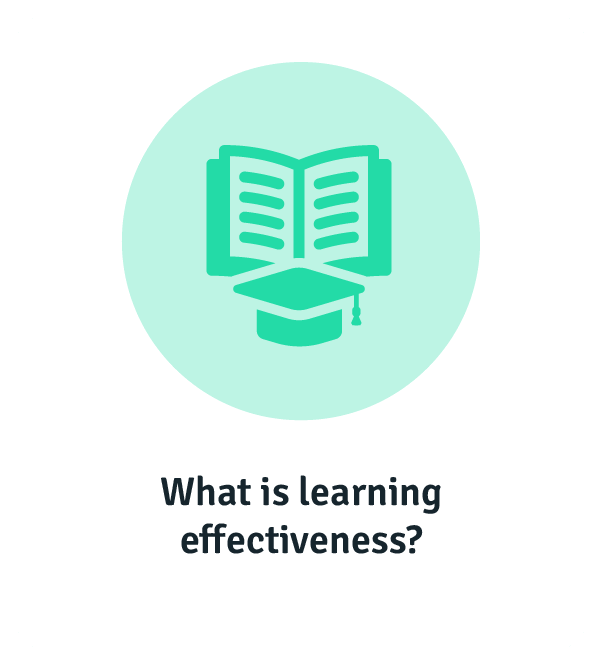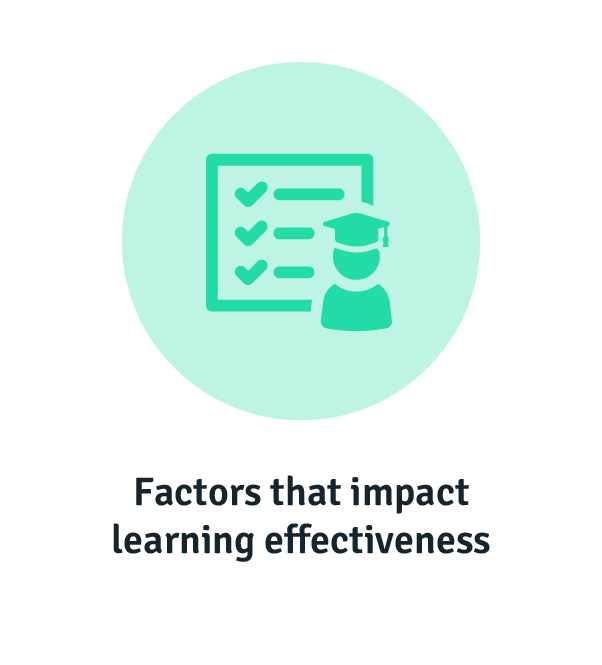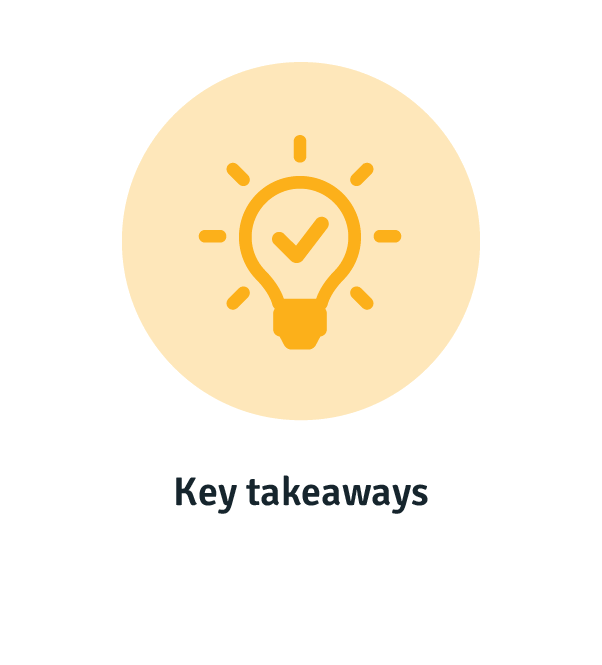Training is a necessary activity for developing your workforce for the future, but it’s not always easy to get right. Just developing training to deliver to employees isn’t enough to ensure that employees actually utilise it to the benefit of the business.
This is where learning effectiveness comes in. It’s the metric that shows how effective training is based on its impact on the business. In this guide, we’ll look at how to measure learning effectiveness and the factors that affect it, as well as six strategies to optimise the learning effectiveness of your training and development programs.
What is learning effectiveness?
Learning effectiveness is a metric designed to measure the efficacy—and therefore success—of training and development in an organisation.
In other words, it focuses on how well training programs met learning outcomes and resulted in learning transfer. It’s a metric that goes beyond completion rates, instead looking at learner engagement in training and development and how well participants retain learned knowledge.
The importance of learning effectiveness for business performance
You can toss out any run-of-the-mill training program and tell employees to do it. The issue is that there’s no guarantee that program will be helpful to either your organisation or employees. Simply being engaged in the learning material isn’t enough. Results are what matter. This is why learning effectiveness is so crucial to L&D—it ensures you can meet learning goals, facilitate incremental change for organisational transformation and prove the value of L&D.
So, how does this work, exactly? As new technologies and processes are discovered and begin to trend, the expectations and standards of your industry will shift in accordance, and it’s up to L&D to close the gap between current and future required capabilities.
Your L&D strategy should match training with specific job responsibilities or pain points. In other words, it should be designed to help employees further business strategy. You’ll be more likely to see knowledge transfer as participants retain and apply their knowledge on the job, as well as behavioural change from your workforce as it becomes more confident and competent in the capabilities required to meet business outcomes.
Aligning L&D strategy with business strategy is a step towards ensuring the learning effectiveness of training programs, and will lead to positive business impacts.
- Increased employee engagement: If employees can see the value in their training, they’ll be more engaged in it. We know, we said engagement wasn’t the be-all and end-all. According to Gallup, only 21% of employees worldwide are engaged with their work. But engaged learners are more likely to retain the information they learn and apply that into their day-to-day behaviours over time, increasing their job performance.
- Improved productivity: More efficient and productive employees (due to effective training) will positively boost your company’s revenue and bottom line. Your return on investment is a good way to justify the value of L&D, allowing for more cost-effective and impactful training in the future.
- Increased organisational performance: As training creates more effective, efficient, and productive employees in their roles, the revenue generated by each employee increases.
- Increased retention rates: Employees who receive more (and better quality) training are more likely to remain with their current employer. Investing in the effectiveness of training decreases employee turnover, leading to lower recruitment, hiring and onboarding costs down the line.
Factors that impact learning effectiveness
The biggest obstacle to learning effectiveness? Motivation. It’s the internal drive to engage and direct a behaviour, and in this case, the behaviour is learning. When participants lack learner motivation, they’re less likely to actively engage with and retain material from their training courses.
So, training effectiveness isn’t just a matter of setting learning materials in front of participants and expecting them to absorb and implement their new knowledge flawlessly. Before you say, “well, I can’t possibly motivate every single employee in my organisation”, remember that with the right information, you can design personalised learning solutions at scale.
Alongside motivation, there are several factors that impact how effective training is, both internal and external.
- The learning environment. This doesn’t just mean the physical environment, although factors such as noise, lighting, and temperature can all effect how well employees engage with their training. This factor also includes delivery modes—in other words, whether your training is delivered face-to-face, via online learning, or blended learning experiences.
- Relevance to employees. Let’s be real: no one wants to sit through hours of training only for none of it to be applicable after the fact. When training isn’t aligned with job roles or business strategy, learners are going to check out. Training needs to be relevant to job responsibilities for employees to get the most out of it.
- Frequency and reinforcement. A fact of knowledge retention is that it doesn’t occur if learned behaviours and knowledge are not applied in job roles regularly. So, if organisations don’t invest in frequent follow-ups, employees are more likely to forget the knowledge learned in training. Real-time feedback can also help here, allowing employees to correct mistakes as they go, thus ensuring they retain the right knowledge.
How to measure learning effectiveness
Learning effectiveness is about meeting learning outcomes, knowledge retention, and transfer of learning, meaning you’re looking for business impact rather than a formula that can spit out a tangible number. This is why you’ll want to use your training return on investment (ROI) to measure how effective your L&D programs are.
So, how do you measure your training ROI in terms of learning effectiveness? Well, let’s take a look at the Kirkpatrick Evaluation Model. It splits training effectiveness into four different levels of engagement to understand the impact on employee behaviour, employee performance, and business performance:
- Reaction
- Learning
- Behaviour
- Results.

1. Reaction
This is the most basic level of measuring learning, based off learner reactions to L&D activities. It focuses on completion rates, progress rates and learner satisfaction, which you can collect with post-training feedback, training evaluations, and surveys. To understand learner reaction, you need to look at:
- Satisfaction, i.e. how satisfied learners were with everything from materials to the amount of time spent learning.
- Intention, or the motivation of learners to apply their new knowledge and skills.
Both satisfaction and intention together create learner reaction, and indicate base-level engagement in learning activities. If this seems too basic to be of any use, consider how engagement affects employees’ abilities to retain knowledge from training and apply it in their day-to-day jobs. Failing to engage learners at this level hinders learning effectiveness and organisational performance as a result.
2. Learning
This stage is about the impact of learning, which looks at whether participants have learned new behaviours. To determine whether a learner has “evolved” their behaviour since training, you need to witness a change in at least two of the following:
- Increase in knowledge
- Change in attitude
- Improvement in skills.
To understand the data here, you need to understand two things, which you can address for future L&D programs accordingly:
- Promoters of learning
- Barriers to learning.
3. Behaviour
Like the second stage, the behaviour stage looks at learning impact in the workplace. This time, however, it’s about looking at the cultural impact of learning, rather than improvement in the individual. This is about looking for that long-lasting incremental change within an organisation, allowing it to transform for the future and create a positive culture of continuous learning.
You won’t be able to measure this stage overnight because, obviously, behavioural change is a long, ongoing process. You’re going to want to measure the increase (or not) in morale, engagement, and learner motivation over a period time.
4. Results
Results are the factors that show impact to the organisation itself. If learning effectiveness was lacking, then you’ll notice little to no change in business performance and outcomes. But, if your training programs were highly effective, you’ll be able to see the how your business was impacted by L&D activities. To understand the organisational impact, look to:
- Increased retention rates
- Higher customer satisfaction
- Increased productivity
- Better sales
- Increased revenue.
These factors are the tangible data that indicate the effectiveness of your L&D programs and, therefore, learning effectiveness. On the other hand, if you don’t see improvements in these areas, that points to issues in your training activities. Perhaps they weren’t aligned with organisational strategy, or just weren’t relevant to participants.
6 strategies to optimise learning effectiveness
Once you know your baseline for learning effectiveness, you can start to improve or optimise it. And there are a few strategies you can use to maximise learning effectiveness in your L&D efforts, but you have to think end to end.
1. Align learning with business objectives
Aligning learning with strategy means employees will be clear on why they should be doing training. When learners don’t understand the point of training, they’re more likely to check out of the learning experience, hindering knowledge retention and transfer of learning. You need to make sure training is aligned with strategic priorities and that you communicate the relevance to participants.
2. Set clear and measurable learning outcomes
If learners don’t really know what they’re meant to be getting out of learning, they aren’t going to have direction. You need to set clear, measurable learning goals for participants to work towards.
Take capabilities, for example. Once you’ve defined the capabilities required for your organisation or specific job roles, you can break them down into individual competencies that employees have to meet. These are measurable levels of proficiency that will show how effective learning has been as participants move up from one competency level to the next.
This will also be helpful after training is complete so you can measure how well those learning outcomes were met.
3. Personalise training
General one-size-fits-all training doesn’t exist. You need to tailor your learning experiences to your business, and to your individual participants. Think on what capabilities employees need to carry out their specific job roles both now and in the future. Then think on the competency they will need to hold to carry those capabilities out effectively.
Personalising training in terms of the capabilities and competencies employees need helps contextualise the necessity for learning, and keeps it relevant to employees’ specific job roles, allowing them to better engage with training. This way, employees are more likely to retain knowledge from training and apply them in their day-to-day roles, driving learning effectiveness.
4. Use a variety of training methods
This could be different delivery modes, resources, or activities. The more interactive the resources and training materials, the more likely this will increase engagement, and, therefore, learning effectiveness.
For example, on-the-job training allows employees to experience a role or responsibilities first-hand and receive feedback in real-time, increasing the likelihood of knowledge being retained.
It’s also important here to make sure your training method is appropriate for what you’re trying to teach. Giving participants a huge library of content to sift through can also be overwhelming for the learner. Instead, it helps to guide learners in the right direction. This way, your employees learn the right things without getting bogged down in pointless or irrelevant content, and they receive the feedback necessary to keep them on track and help them improve and build upon what they’ve learned.
5. Reinforce and follow up
The Forgetting Curve shows that knowledge is lost over time if it’s not being put to use. To solve this, learners should receive follow up training, activities, and feedback, to reinforce what they learned. The best way to do this is by reinforcing training at regular intervals, creating the spacing effect. It allows learners to keep applying their knowledge before they have a chance to forget critical information.
6. Evaluate your learning outcomes
Here is where you go about evaluating the goals you set at the beginning of training. When you measure how well outcomes were met, you’ll be able to identify areas that went well and others that might not have. If you find areas that are lacking, you can develop methods to address them for future training and development activities.
Key takeaways
Learning effectiveness is about how well learning outcomes and goals were met, and how learning solutions have impacted business outcomes, if at all. It allows organisations to keep their workforce up-to-date on the latest industry standards, as well as prepare that workforce for the future, increasing agility and performance.
There are six strategies you can implement to maximise learning effectiveness in your L&D programs:
- Align learning with business objectives
- Set clear and measurable goals
- Personalise training
- Use a variety of training methods
- Reinforce and follow-up
- Evaluate training outcomes.
Related Reads on This Topic

How to Measure and Prove ROI in Training & Development
ROI in training is crucial for measuring the business impact of training. We dive into how to calculate it for your training program…

Your Training Evaluation Report Template & How to Use It
Get your free downloadable training evaluation report template, as well as a full guide on how to analyse training impact…

How to Ensure Post-Training Knowledge Retention in the Workplace
Knowledge retention in employees is retained knowledge for your business. We look at five strategies to encourage it for your organisation…





